Configurations and testing methodology
Obviously, the most interesting topics have
been raised in the comparison between the Core i7 4770K based on Haswell
microarchitecture and the Core i7-3770K based on the previous Ivy Bridge
microarchitecture. However, we do not intend to stop there but would like to
add some more about LGA20011 CPU which is based on the Sandy Bridge platform
with long life cycles. That is the fastest six-core Core i7-3970X Extreme
Edition and the quad-core Core i7-3820. Besides, we have conducted some tests
on the AMD Piledriver –FX-8350 processor.
A separate topic for discussion is the
integrated graphics core inside the Core i7-4770K processor. When we finish
measuring its performance, the results are compared to the figures of Core
i7-3770K and other AMD APU models at that time – A10-5800K.
As the result, our testing models are
configured by using software and other hardware as follow:
·
Processors:
ü AMD
A10-5800K (Trinity, 4 cores, 3.8-4.2 GHz, 4 MB L2);
ü AMD
FX-8350 (Vishera, 8 cores, 4.0-4.2 GHz, 4 x 2 MB L2, 8 MB L3);
ü Intel
Core i7-3770K (Ivy Bridge, 4 cores + HT, 3.5-3.9 GHz, 4 x 256 KB L2, 8 MB L3);
ü Intel
Core i7-3820 (Sandy Bridge-E, 4 cores + HT, 3.6-3.8 GHz, 4 x 256 KB L2, 10 MB
L3);
ü Intel
Core i7-3970X Extreme Edition (Sandy Bridge-E, 6 cores + HT, 3.5-4.0 GHz, 6 x
256 KB L2, 15 MB L3);
ü Intel
Core i7-4770K (Haswell, 4 cores + HT, 3.5-3.9 GHz, 4 x 256 KB L2, 8 MB L3).
·
Processor cooler: NZXT Havik 140.
·
Mainboards:
ü ASUS
Crosshair V Formula (Socket AM3+, AMD 990FX + SB950);
ü ASUS
F2A85-V Pro (Socket FM2, AMD A85);
ü ASUS
P8Z77-V Deluxe (LGA 1155, Intel Z77 Express);
ü ASUS
Rampage IV Formula (LGA 2011, Intel X79 Express);
ü Gigabyte
Z87X-UD3H (LGA 1150, Intel Z87 Express).
·
Graphics card: Nvidia GeForce GTX 680 (2 GB/256
bit GDDR5, 1006/6008 MHz).
·
Memory:
ü 2 x
4 GB, DDR3-1866 SDRAM, 9-11-9-27 (Kingston KHX1866C9D3K2/8GX);
ü 4 x
4 GB, DDR3-1866 SDRAM, 9-11-9-27 (Kingston KHX1866C9D3K2/8GX).
·
Disk sub-system: Intel SSD 520 240 GB
(SSDSC2CW240A3K5).
·
Power supply unit: Corsair AX760i (80 Plus
Platinum, 760 W).
·
Operating system: Microsoft Windows 8 Enterprise
x64.
·
Drivers:
ü AMD
Catalyst 13.4 Driver;
ü AMD
Chipset Driver 13.4;
ü Intel
Chipset Driver 9.4.0.1017;
ü Intel
Graphics Media Accelerator Driver 15.31.3.64.3071;
ü Intel
Management Engine Driver 9.5.0.1345;
ü Intel
Rapid Storage Technology 12.5.0.1066;
ü NVIDIA
GeForce 320.18 Driver.
Performance
The general performance
As usual, we use BAPCo SYSmark 2012 to estimate
the internal processing’s performance in general purpose tasks. It emulates the
usage models in popular office and creates digital content and processing
applications. The main idea behind this test is rather simple: it creates one
single score which is typical for the average computer performance. After the
introduction of Windows 8 SYSmark 2012 was upgraded to the version 1.5, this is
the version that we are actually using in our testing session.
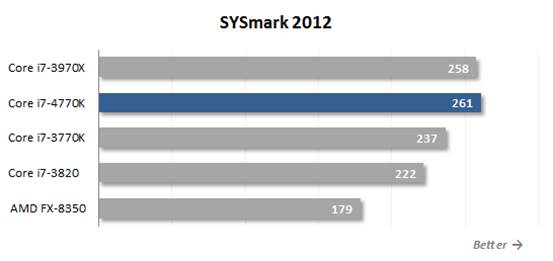
SYSmark
2012
As we expected, the transforming process of
the new Core processor to the new generation microarchitecture does not produce
any impressive effects. The SYSmark indicates that the performance of Core
i7-4770K is higher than its predecessor which is based on Ivy Bridge microarchitecture,
the Core i7-3770K, just 10%. However, this increase is even enough to put the
Core i7-4770K at higher position in the Core i7 3970X line in terms of general
performance. Just like the advantage of Haswell in quad-core Sandy Bridge Core
i7-3820, it is quite obvious and achieves 18%. However, do not forget that Core
i7-3820 and Core i7 4770K are two generations of processor design apart.
Let’s take a closer look at the performance
score that SYSmark 2012 has recorded in different using scenarios. The Office
Productivity scenario emulates the typical office usage, for example editing
documents, processing electronic tables, email and surfing Internet. This
scenario uses the following applications: ABBYY FineReader Pro 10.0, Adobe
Acrobat Pro 9, Adobe Flash Player 10.1, Microsoft Excel 2010, Microsoft
Internet Explorer 9, Microsoft Outlook 2010, Microsoft PowerPoint 2010,
Microsoft Word 2012 and WinZip 14.5
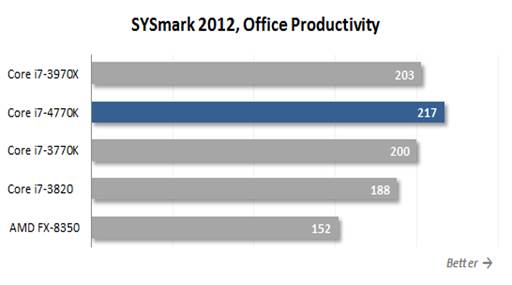
SYSmark
2012, Office Productivity
The Media Creation scenario emulates video
clip creation using digital images and available videos. Here, they use very
popular features from Adobe like Photoshop CS5 Extended, Premiere Pro CS5 and
After Effects CS5.
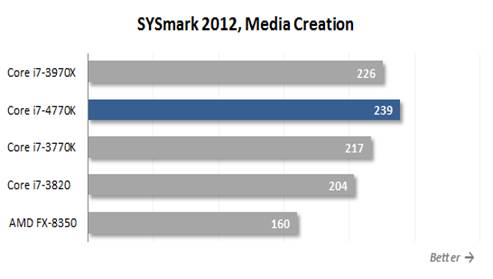
SYSmark
2012, Media Creation
Web Development is for emulating web
designing. The following applications have been uses: Adobe Photoshop CS5
Extended, Adobe Premiere Pro CS5, Adobe Dreamweaver CS5, Mozilla Firefox 3.6.8
and Microsoft Internet Explorer 9.

SYSmark
2012, Web Development
The Data/Financial Analysis is used to
analyze the statistics and predict the market tendency, which is done by
Microsoft Excel 2010.

SYSmark
2012, Data/ Financial Analysis
The 3D Modeling scenario is completely
designed for the 3D subjects and it also provides static and dynamic scenes
using Adobe Photoshop CS5 Extended, Autodesk 3ds Max 2011, Autodesk AutoCAD
2011 and Google SketchUp Pro 8.

SYSmark
2012, 3D Modeling
The last scenario is called System
Management which creates the backups and installs software and updates. It
might be related to different versions of Mozilla Firefox browser and WinZip
14.5

SYSmark
2012, System management
The new Haswell microarchitecture shows the
highest performance during well-paralleled multi-threaded load, and this
definitely is another evidence for the benefits of the changes introduced in
it, which is helping improve the efficiency of Hyper-Threading technology. However,
Core i7 4770K becomes the premium leader in difference scenarios: from typical
office to home use scenarios such as System Management, Media Creation and
Office Productivity.
Gaming
performance
As you may know, it is the graphics system
which is used to determine the performance of the entire platform equipped with
quite high-speed processor in most of the modern games. Therefore, we choose
games which are the most CPU-dependent and take the fps reading twice. There is
no antialiasing is used in the first test run and the selected resolution is
also not the highest one. These settings would help us determine how the
processor manages to process the gaming loads in general and how the tested
CPUs react in the very near future, when the new faster graphics card model is
widely spread. The second test run is conducted with more real-life settings –
with FullHD as the resolution and the maximum FSAA. In our opinion, these
results are just not interesting enough, but they do clearly show the level of
performance that we have expected from contemporary processor today.
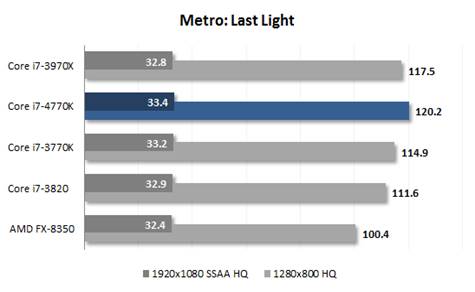
Metro:
Last night

F1
2012
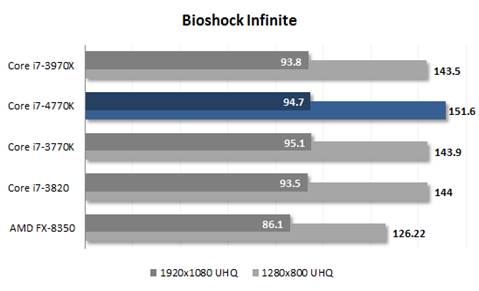
Bioshock
Infinite
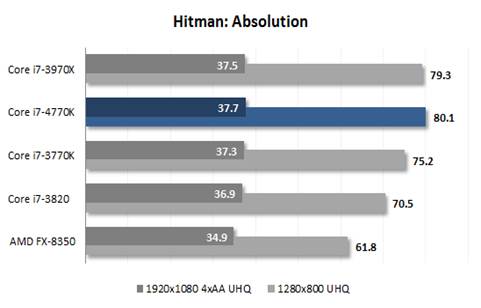
Hitman:
Absolution

Borderlands
2

Crysis
3
If we look at the gaming performance with
the practical graphics settings, it seems to be very reasonable that there
would be very few differences with other premium products in this segment. Both:
Core i7 770 K and Core i7 3770K, show about the same fps rate, because main
point in both cases is the graphics card. If the games are like the synthetic
benchmarks measuring the computing performance and the lower resolution is to
ensure these CPUs to be the main determinative factor in the test, we will easily
recognize some positive changes. The Haswell processor would be 5% faster on
average compared to the Ivy model. Moreover, in many cases, the LGA1150
platform will become a better gaming platform than the LGA2011 platform.